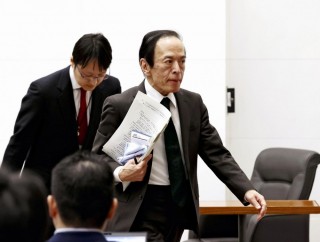Loading
Search
▼ Bank of Japan Governor Lauded For Smooth Policy Change; Future Interest Rate Hikes to be Focus of Attention
- Category:Other
Tuesday will mark one year since Bank of Japan Gov. Kazuo Ueda took office. Market players have praised his skill in ending 11 years of massive monetary easing, but the key point of this exit is still to come. The next move, including additional interest rate hikes, will be a focus of attention for the Japanese central bank under Ueda.
“Based on the results of the spring labor-management wage negotiations, the basic growth rate of consumer prices will gradually increase,” Ueda said at a meeting of the House of Representatives Financial Affairs Committee on Friday, reiterating his confidence that the price stability target of 2% inflation will be achieved.
In April last year, Ueda became the first postwar BOJ governor from an academic background. In July and October 2023, he changed the operation of the yield curve control, and in March this year he lifted the negative interest rate policy and eliminated the yield curve control.
Those moves marked a quick end to the framework of large-scale monetary easing measures introduced by former Gov. Haruhiko Kuroda.
Many market players commended Ueda’s monetary management.
“He was able to smoothly end the large-scale easing without missing the opportunity of large wage hikes in the spring labor-management wage negotiations,” said Tsuyoshi Ueno of NLI Research Institute. “As he is a scholar, his explanations are well reasoned, and they are also detailed and easy to understand.”
Normal monetary policy
At a press conference following a Monetary Policy Meeting on March 19, Ueda stressed that there will be a “normal monetary policy” in the future.
With the lifting of the negative interest rate policy, short-term interest rates have moved into positive territory for the first time in about eight years. “There is no confusion in the market, and the [policy change] has landed fine,” said Masahiro Ichikawa of Sumitomo Mitsui DS Asset Management Co.
The end of the negative interest rate policy resulted in only an about 0.1% increase in interest rates, and market attention is turning to additional rate hikes.
Behind the speculation about additional interest rate hikes is the expectation that companies will pass on higher wages to selling prices, increasing the probability that the price stability target will be realized.
With the government’s income tax cut coming in June, some in the market believe an additional rate hike could occur as early as this summer.
However, deciding on an additional rate hike is not easy. Another rate increase could adversely affect the economy, causing a further deterioration in consumer spending, which was already weakening, and a greater borrowing burden on businesses and households.
Quantitative tightening
The handling of Japanese government bonds purchased by the BOJ is also a difficult task.
According to preliminary Flow of Funds statistics released last month, the outstanding amount of government bonds held by the central bank stood at ¥581 trillion as of the end of December, accounting for 53.8% of overall bond holdings. To normalize monetary policy, a reduction in the outstanding amount of government bonds is inevitable.
At the lower house committee session on Friday, Ueda expressed his desire to introduce quantitative tightening. “In the future, we want to reduce the amount of bond purchases and shift to a situation in which [the outstanding amount] shrinks along with the redemption of bonds,” Ueda said.
When a large amount of government bonds are held by the central bank, that itself keeps long-term interest rates low. This is why the BOJ has continued to purchase about ¥6 trillion of government bonds per month for the time being, to maintain the amount it holds. A reduction of the holding could cause a sharp rise in long-term interest rates.
- April 6, 2024
- Comment (0)
- Trackback(0)


